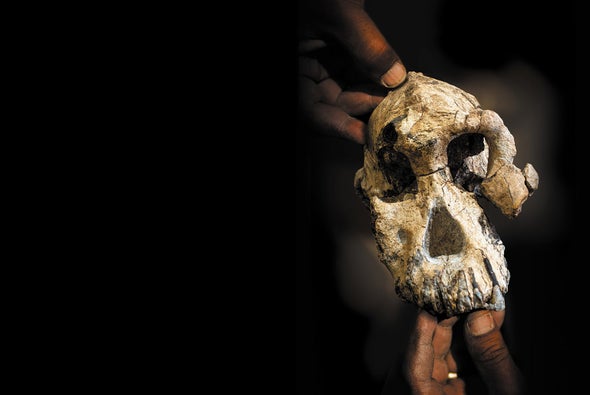by KATE WONG

Australopithecus anamensis. PHOTO/Dale Omori and Liz Russell (photograph); Jennifer Taylor and Cleveland Museum of Natural History (composite image of hands holding “MRD”)
A long-sought fossil could redraw our family tree
Nearly 25 years after scientists described the first fossil traces of Australopithecus anamensis, this unsung human ancestor is finally having its moment. Researchers working in Ethiopia have found a nearly complete cranium of this long-vanished member of the hominin group, which includes Homo sapiens and its close extinct relatives. The fossil, dated to 3.8 million years ago, reveals the never before seen face of A. anamensis, a species previously known mainly from jaws, teeth and a smattering of bones from below the head. Traits evident in the specimen hint that our family tree may need revising.
By some accounts, A. anamensis is the oldest unequivocal hominin, with some fossils dating from as far back as 4.2 million years ago. For years it has occupied a key position in the family tree as the lineal ancestor of Australopithecus afarensis, which is widely viewed as the ancestor of our own genus, Homo. Based on the ages and characteristics of the available fossils, paleoanthropologists thought A. anamensis gave rise to A. afarensis through an evolutionary process termed anagenesis, in which one species transforms into another. The new fossil throws a wrench into the works of that theory.
Yohannes Haile-Selassie of the Cleveland Museum of Natural History and his colleagues recovered the cranium from an area in northeastern Ethiopia’s Afar region known as Woranso-Mille. Features of its teeth and jaws link it to the previously known fragmentary remains of A. anamensis. The fossil shows a creature with a projecting face, large canine teeth, flaring cheekbones, a crest atop its head that anchored strong jaw muscles, and a long, narrow braincase that held a brain the size of a chimpanzee’s. The discovery team suspects the cranium belonged to an adult male A. anamensis.
Scientific American for more